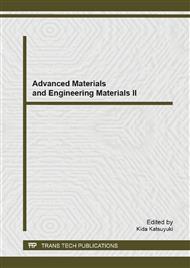[1]
J. Appenzeller, J. Knoch, R. Martel, V. Derycke, S. J. Wind and P. Avouris. Carbon nanotube electronics. Ieee Trans. Nanotechnol. 2002, 1 (4): 184-189.
DOI: 10.1109/tnano.2002.807390
Google Scholar
[2]
A. Javey, H. Kim, M. Brink, Q. Wang, A. Ural, J. Guo, P. McIntyre, P. McEuen, M. Lundstrom and H. Dai. High-[kappa] dielectrics for advanced carbon-nanotube transistors and logic gates. Nat Mater 2002, 1 (4): 241-246.
DOI: 10.1038/nmat769
Google Scholar
[3]
A. Javey, J. Guo, Q. Wang, M. Lundstrom and H. Dai. Ballistic carbon nanotube field-effect transistors. Nature 2003, 424 (6949): 654-657.
DOI: 10.1038/nature01797
Google Scholar
[4]
C. M. Aguirre, S. Auvray, S. Pigeon, R. Izquierdo, P. Desjardins and R. Martel. Carbon nanotube sheets as electrodes in organic light-emitting diodes. Appl. Phys. Lett. 2006, 88 (18): 183104.
DOI: 10.1063/1.2199461
Google Scholar
[5]
K. Bradley, J. C. P. Gabriel and G. Gruner. Flexible nanotube electronics. Nano Lett. 2003, 3 (10): 1353-1355.
Google Scholar
[6]
E. S. Snow, J. P. Novak, P. M. Campbell and D. Park. Random networks of carbon nanotubes as an electronic material. Appl. Phys. Lett. 2003, 82 (13): 2145-2147.
DOI: 10.1063/1.1564291
Google Scholar
[7]
T. Ozel, A. Gaur, J. A. Rogers and M. Shim. Polymer electrolyte gating of carbon nanotube network transistors. Nano Lett. 2005, 5 (5): 905-911.
DOI: 10.1021/nl0503781
Google Scholar
[8]
E. Bekyarova, M. E. Itkis, N. Cabrera, B. Zhao, A. P. Yu, J. B. Gao and R. C. Haddon. Electronic properties of single-walled carbon nanotube networks. J. Am. Chem. Soc. 2005, 127 (16): 5990-5995.
DOI: 10.1021/ja043153l
Google Scholar
[9]
D. S. Bethune, C. H. Kiang, M. S. deVries, G. Gorman, R. Savoy, J. Vazquez and R. Beyers. Cobalt-catalysed growth of carbon nanotubes with single-atomic-layer walls. Nature 1993, 363 (6430): 605-607.
DOI: 10.1038/363605a0
Google Scholar
[10]
A. Javey, H. Kim, M. Brink, Q. Wang, A. Ural, J. Guo, P. McIntyre, P. McEuen, M. Lundstrom and H. Dai. High- k dielectrics for advanced carbon-nanotube transistors and logic gates. Nat. Mater. 2002, 1 (4): 241-246.
DOI: 10.1038/nmat769
Google Scholar
[11]
Z. Fan, J. C. Ho, Z. A. Jacobson, R. Yerushalmi, R. L. Alley, H. Razavi and A. Javey. Wafer-Scale Assembly of Highly Ordered Semiconductor Nanowire Arrays by Contact Printing. Nano Lett. (2007).
DOI: 10.1021/nl071626r
Google Scholar
[12]
A. Javey, Q. Wang, A. Ural, Y. M. Li and H. J. Dai. Carbon nanotube transistor arrays for multistage complementary logic and ring oscillators. Nano Lett. 2002, 2 (9): 929-932.
DOI: 10.1021/nl025647r
Google Scholar
[13]
A. Javey, S. Nam, R. S. Friedman, H. Yan and C. M. Lieber. Layer-by-layer assembly of nanowires for three-dimensional, multifunctional electronics. Nano Lett. 2007, 7 (3): 773-777.
DOI: 10.1021/nl063056l
Google Scholar
[14]
Y. M. Li, D. Mann, M. Rolandi, W. Kim, A. Ural, S. Hung, A. Javey, J. Cao, D. W. Wang, E. Yenilmez, Q. Wang, J. F. Gibbons, Y. Nishi and H. J. Dai. Preferential growth of semiconducting single-walled carbon nanotubes by a plasma enhanced CVD method. Nano Lett. 2004, 4 (2): 317-321.
DOI: 10.1021/nl035097c
Google Scholar
[15]
Z. C. Wu, Z. H. Chen, X. Du, J. M. Logan, J. Sippel, M. Nikolou, K. Kamaras, J. R. Reynolds, D. B. Tanner, A. F. Hebard and A. G. Rinzler. Transparent, conductive carbon nanotube films. Science 2004, 305 (5688): 1273-1276.
DOI: 10.1126/science.1101243
Google Scholar
[16]
A. Behnam, Y. Choi, L. Noriega, Z. C. Wu, I. Kravchenko, A. G. Rinzler and A. Ural. Nanolithographic patterning of transparent, conductive single-walled carbon nanotube films by inductively coupled plasma reactive ion etching. J. Vac. Sci. Technol. B 2007, 25 (2): 348-354.
DOI: 10.1116/1.2699836
Google Scholar


